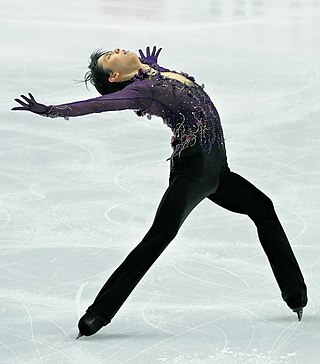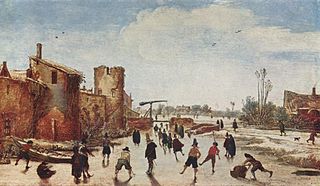
Figure skating is a sport in which individuals, pairs, or groups perform on figure skates on ice. It was the first winter sport to be included in the Olympic Games, with its introduction occurring at the 1908 Olympics in London. The Olympic disciplines are men's singles, women's singles, pair skating, and ice dance; the four individual disciplines are also combined into a team event, which was first included in the Winter Olympics in 2014. The non-Olympic disciplines include synchronized skating, Theater on Ice, and four skating. From intermediate through senior-level competition, skaters generally perform two programs, which, depending on the discipline, may include spins, jumps, moves in the field, lifts, throw jumps, death spirals, and other elements or moves.

The 1952 Winter Olympics, officially known as the VI Olympic Winter Games and commonly known as Oslo 1952, were a winter multi-sport event held from 14 to 25 February 1952 in Oslo, the capital of Norway.

Katarina Witt is a German former figure skater. A two-time Olympic champion, Witt is regarded as one of the greatest ladies' singles figure skaters of all time. Her Laureus profile states that "she is remembered most for her overall athleticism, her charismatic appeal and her glamorous image on the ice."

Midori Ito is a retired Japanese figure skater. She is the 1989 World champion and the 1992 Olympic silver medalist. She is the first woman to land a triple-triple jump combination and a triple Axel in competition. At the 1988 Calgary Olympics, she became the first woman to land seven triple jumps in an Olympic free skating competition. She is widely recognised as one of the best figure skaters of all time.

Richard Totten Button is an American former figure skater and skating analyst. He was a two-time Olympic champion and five-time consecutive World champion (1948–1952). He was also the only non-European man to have become European champion. Button is credited as having been the first skater to successfully land the double Axel jump in competition in 1948, as well as the first triple jump of any kind – a triple loop – in 1952. He also invented the flying camel spin, which was originally known as the "Button camel". He "brought increased athleticism" to figure skating in the years following World War II. According to figure skating historian James R. Hines, Button represented the "American School" of figure skating, which was a more athletic style than skaters from Europe.
Figure skating at the 1948 Winter Olympics took place at the Olympic Ice Rink in St. Moritz, Switzerland. Three figure skating events were contested: men's singles, ladies' singles, and pair skating.

Figure skating at the 1988 Winter Olympics took place at the Stampede Corral, the Olympic Saddledome and the Father David Bauer Olympic Arena in Calgary, Alberta, Canada. This was the last Olympic competition where compulsory figures were contested for the men's and ladies' events.

Figure skating at the 1928 Winter Olympics took place at the Olympic Ice Rink in St. Moritz, Switzerland, between 14 and 19 February 1928. Three figure skating events were contested: men's singles, ladies' singles, and pair skating.

Janet Lynn Nowicki is an American figure skater. She is the 1972 Olympic bronze medalist, a two-time world championships medalist, and a five-time senior Ladies U.S. national champion.
The figure skating events at the 1972 Winter Olympics were held at the Makomanai Skating Rink and the Mikaho Indoor Skating Rink.

Mao Asada is a Japanese former competitive figure skater. She is the 2010 Olympic silver medalist, a three-time World champion, a three-time Four Continents champion, and a four-time Grand Prix Final champion. She is the first female figure skater who has landed three triple Axel jumps in one competition, which she achieved at the 2010 Winter Olympics.
Figure skating is a sport with participants across the world. Originally based in North America and Europe, the sport has experienced a major expansion in the countries of East Asia. The international governing body of the sport is the International Skating Union (ISU). Only those nations which are members of the International Skating Union are allowed to compete in the figure skating events in the Olympic Games.
The ISU Judging System or the International Judging System (IJS), occasionally referred to as the Code of Points (COP) system, is the scoring system that has been used since 2004 to judge the figure skating disciplines of men's and ladies' singles, pair skating, ice dance, and synchronized skating. It was designed and implemented by the International Skating Union (ISU), the ruling body of the sport.

The history of figure skating stretches back to prehistoric times. Primitive ice skates appear in the archaeological record from about 3000 BC. Edges were added by the Dutch in the 13th and 14th century. International figure skating competitions began appearing in the late 19th century; in 1891, the European Championships were inaugurated in Hamburg, Germany, and in 1896, the first World Championship were held in Saint Petersburg, Russian Empire. At the 1908 Summer Olympics in London, England, figure skating became the first winter sport to be included in the Olympics.
The 2009 Four Continents Figure Skating Championships an international figure skating competition in the 2008–09 season. It was held at the Pacific Coliseum in Vancouver, Canada on February 2–8. Medals were awarded in the disciplines of men's singles, ladies' singles, pair skating, and ice dancing. The compulsory dance was the Finnstep.

Figure skating at the 2010 Winter Olympics was held at the Pacific Coliseum in Vancouver, British Columbia, Canada. The events took place between 14 and 27 February 2010.
The 1971 European Figure Skating Championships was a senior-level international competition held at the Hallenstadion in Zürich, Switzerland on February 2–7. Elite senior-level figure skaters from European ISU member nations competed for the title of European Champion in the disciplines of men's singles, ladies' singles, pair skating, and ice dancing.
The men's figure skating competition at the 1952 Winter Olympics took place on 19 and 21 February at Jordal Amfi and Bislett stadion. The compulsory figures were held at Jordal Amfi, while the Free skating was contested at Bislett stadion. The ice surface at Bislett was set inside the oval created by the speed skating track. It was also an outdoor arena, which was used for the opening and closing ceremonies. There were no issues with the weather and the skating surface at Bislett was immaculate. Computers were used for the first time during the figure skating competitions to help tabulate the judges' marks and relay the results instantaneously.

A figure skating rink is an ice rink intended for or compatible with the practice of figure skating. In many locations, it is shared with other sports—typically ice hockey and/or short track speed skating.
The 2019–20 Grand Prix of Figure Skating Final and ISU Junior Grand Prix Final was held from December 5–8, 2019 at the Torino Palavela in Turin, Italy. The combined event was the culmination of two international series — the Grand Prix of Figure Skating and the Junior Grand Prix. Medals were awarded in the disciplines of men's singles, ladies' singles, pair skating, and ice dance on the senior and junior levels.











